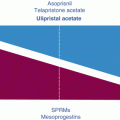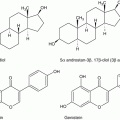Fig. 14.1
Abdominal to gynoid deposit ratio (A/G ratio) in different obesity phenotypes of postmenopausal women. Abbreviations: MONW, metabolic obesity with normal weight; MHO, metabolic healthy obesity; OWMD, obesity with metabolic disorders
Serum level of atheroprotective adiponectin in subjects with metabolic healthy obesity is significantly higher in comparision with those with obesity with metabolic disorders; likewise, serum level ofadiponectin in control subjects with normal weight without metabolic disturbances is higher in comparison with those with metabolic obesity with normal weight (Fig. 14.2).


Fig. 14.2
Serum level of adiponectin (μg/ml). * p < 0.001
The adipose tissue distribution is connected with three main obesity phenotypes: “healthy” obesity, obesity with metabolic disorders, and metabolic obesity with normal weight. The excessive visceral fat deposit and the pathological storage of fat in muscles and liver play a key role in metabolic disorders.
The occurrence of metabolic disorders and higher visceral fat deposit in these patients qualifies for lifestyle modification and pharmacotherapy. Who should be treated then? These should be patients with diagnosed obesity with metabolic disorders and metabolic obesity with normal weight. Clinical indictaions fot treatment are waist circumference >80 cm in females and >94 cm in males, BMI >30.0 kg/m2, adipose tissue mass >35 %, fasting glucose level ≥100 mg/dl, serum triglycerides level >150 mg/dl, HDL cholesterol in females <50 mg/dl and in males <40 mg/dl, and hypertension >130/85 mmHg. Metformin is recomended in pharmacological theraphy. There are data that metformin induces alterations in the body composition: reduces total fat tissue mass by 7 % and visceral fat mass by 15 %.
References
1.
WHO (1998) Obesity: preventing and managing the global epidemic. WHO/NUT/NCD/98. Report of a WHO consultation on Obesity, Geneva
2.
3.
Hara M, Alcoser SY, Qaadir A, Beiswenger KK, Cox NJ, Ehrmann DA (2002) Insulin resistance is attenuated in women with polycystic ovary syndrome with the Pro(12)Ala polymorphism in the PPARgamma gene. J Clin Endocrinol Metab 87(2):772–775PubMed
4.
5.
6.
Snijder MB, Van Dam RM, Visser M, Seidell JC (2006) What aspects of body fat are particularly hazardous and how do we measure them? Int J Epidemiol 35(1):83–92CrossRefPubMed
Stay updated, free articles. Join our Telegram channel

Full access? Get Clinical Tree





